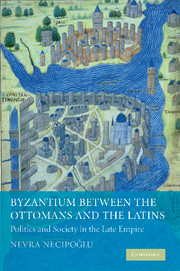Book contents
- Frontmatter
- Contents
- List of maps
- Acknowledgements
- Note on transliteration
- List of abbreviations
- Map 1 The Byzantine world in the fourteenth–fifteenth centuries
- Map 2 Byzantium and its neighbors, c. 1350
- Map 3 Byzantium and its neighbors after 1402
- PART I INTRODUCTION AND POLITICAL SETTING
- PART II THESSALONIKE
- 3 Social organization, historical developments, and political attitudes in Thessalonike: an overview (1382–1430)
- 4 Byzantine Thessalonike (1382–1387 and 1403–1423)
- 5 Thessalonike under foreign rule
- PART III CONSTANTINOPLE
- PART IV THE DESPOTATE OF THE MOREA
- Conclusion
- Appendix I Archontes of Thessalonike (fourteenth—fifteenth centuries)
- Appendix II “Nobles” and “small nobles” of Thessalonike (1425)
- Appendix III Constantinopolitan merchants in Badoer's account book (1436–1440)
- Appendix IV Members of the Senate of Constantinople cited in the synodal tome of August 1409
- Appendix V Some Greek refugees in Italian territories after 1453
- Bibliography
- Index
4 - Byzantine Thessalonike (1382–1387 and 1403–1423)
Published online by Cambridge University Press: 07 December 2009
- Frontmatter
- Contents
- List of maps
- Acknowledgements
- Note on transliteration
- List of abbreviations
- Map 1 The Byzantine world in the fourteenth–fifteenth centuries
- Map 2 Byzantium and its neighbors, c. 1350
- Map 3 Byzantium and its neighbors after 1402
- PART I INTRODUCTION AND POLITICAL SETTING
- PART II THESSALONIKE
- 3 Social organization, historical developments, and political attitudes in Thessalonike: an overview (1382–1430)
- 4 Byzantine Thessalonike (1382–1387 and 1403–1423)
- 5 Thessalonike under foreign rule
- PART III CONSTANTINOPLE
- PART IV THE DESPOTATE OF THE MOREA
- Conclusion
- Appendix I Archontes of Thessalonike (fourteenth—fifteenth centuries)
- Appendix II “Nobles” and “small nobles” of Thessalonike (1425)
- Appendix III Constantinopolitan merchants in Badoer's account book (1436–1440)
- Appendix IV Members of the Senate of Constantinople cited in the synodal tome of August 1409
- Appendix V Some Greek refugees in Italian territories after 1453
- Bibliography
- Index
Summary
In the late fourteenth and early fifteenth centuries Thessalonike was no longer the thriving city it used to be in the earlier part of the Palaiologan period. Subjected from the 1380s onwards to continuous Ottoman assaults and sieges, it was completely cut off by land. Because of the insecurity of the surrounding countryside, the fields outside the city walls remained untilled. Commercial activity was disrupted due to the city's isolation from its hinterland. As early as 1384 or 1385 Demetrios Kydones wrote that the suburbs of Thessalonike were devastated and that its once flourishing market was reduced to misery. This picture of economic decline is confirmed by archaeological evidence, which has revealed no sign of any major construction activity inside the city or in the surrounding countryside after 1380. In the subsequent generation Symeon described how Mehmed I interfered with the food supplies in 1417/18 and also lamented the breakdown of business within the city and the destruction of the lands outside during the siege of 1422–3. The city gates seem to have remained closed throughout the duration of the Ottoman threat. The only regular access that Thessalonians had to the outside world was by sea, and it was by this means that the provisioning of the city was maintained during these critical times.
- Type
- Chapter
- Information
- Byzantium between the Ottomans and the LatinsPolitics and Society in the Late Empire, pp. 56 - 83Publisher: Cambridge University PressPrint publication year: 2009



